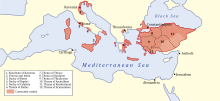Leo III the Isaurian
| Leo III the Isaurian | |
|---|---|
Isaurian dynasty | |
| Religion | Chalcedonian Christianity |
Leo III the Isaurian (
Early life
Leo III was born in
After the victory of
Konon was appointed commander (stratēgos) of the Anatolic Theme by Emperor Anastasius II. On his deposition, Konon joined with his colleague Artabasdos, the stratēgos of the Armeniac Theme, in conspiring to overthrow the new Emperor Theodosius III. Artabasdos was betrothed to Konon's daughter Anna.[8]
Siege of Constantinople
Leo entered Constantinople on 25 March 717 and forced the abdication of Theodosius III, becoming emperor as Leo III. The new emperor was immediately forced to attend to the
Careful preparations, begun three years earlier under Anastasius II, and the stubborn resistance put up by Leo wore out the invaders. An important factor in the victory of the Byzantines was their use of
Faced with the Bulgarian onslaught, the impenetrability of Constantinople's walls, and their own exhausted provisions, the Arabs were forced to abandon the siege in August 718. Sulayman had died the previous year, and his successor
Reign

Having thus saved the Empire from extinction, Leo proceeded to consolidate its administration, which in the previous years of anarchy had become completely disorganized. In 718 he suppressed a rebellion in Sicily;[11] the following year saw the deposed Emperor Anastasius II raise an army and attempt to retake the throne, but he was captured and executed by Leo's government.
Leo secured the Empire's frontiers by inviting
Leo undertook a set of civil reforms including the abolition of the system of prepaying taxes which had weighed heavily upon the wealthier proprietors, the elevation of the
Iconoclastic policies

Leo's most striking legislative reforms dealt with religious matters, especially
A revolt broke out in Greece under the leadership of
In the
Scholars have discussed the mutual influence of Muslim and Byzantine iconoclasm, noting that
Legislation
The legislative reforms of Leo III and his successor Constantine V transformed the Byzantine orphanotrophos into a magistrate. Prior to these legislative reforms, Byzantine law required that all orphans are passed into the Byzantine orphanage or to a monastery.[20]
Coinage
The coins minted during Leo's reign exclusively depicted male imperial dynasts, promoting the dynastic order of succession. The gold coins of Leo IV the Khazar show posthumous portraits of Leo III.[21]
Death and family

Leo III died of
With his wife Maria, Leo III had four known children:
- Constantine V, born in 718. He was crowned co-emperor in 720 and became senior emperor in 741.
- Anna, born before 705. She married the future emperor Artabasdos.[23]
- Kosmo and Irene. They were both buried in a sarcophagus of Proconnesian marble in the Church of the Apostles.[24]
Legacy
This section needs expansion. You can help by adding to it. (November 2023) |
In 1573 a translation of John of Damascus' attack on Leo III was published, under the title Apologie divisee en troits livres contre Leon Isaure, triggering religious controversy.[25]
See also
References
- ISBN 978-0-205-80766-6.)
{{cite book}}: CS1 maint: multiple names: authors list (link - ISBN 90-429-0387-2.
- ISBN 9781175927651.
- ISBN 0333631420.
- ISBN 0415243572.
- ^ A. A. Vasiliev (1964). History of the Byzantine Empire, 324-1453, Volume 1. University of Wisconsin Press. p. 255.
- ISBN 0812211286.
- ISBN 0804726302.
- ^ (in French) Guilland, Rodolphe. "L’expédition de Maslama contre Constantinople (717–720)" in Études Byzantines. Paris: Presses universitaires de France, 1959, pp. 109–133.
- ^ Treadgold. History of the Byzantine State, p. 347.
- ^ "Leo III the Isaurian (ca. 680–741) - Weapons and Warfare". 15 January 2020. Retrieved 6 March 2024.
- ^ "Leo III the Isaurian (ca. 680–741) - Weapons and Warfare". 15 January 2020. Retrieved 6 March 2024.
- ^ "Leo III the Isaurian (ca. 680–741) - Weapons and Warfare". 15 January 2020. Retrieved 6 March 2024.
- ^ Freshfield, Edwin (March 1930). The Official Manuals of Roman Law of the Eighth and Ninth Centuries. Cambridge, United Kingdom: Cambridge Law Journal and Contributors. p. 35.
- ^ Ladner, Gerhart. "Origin and Significance of the Byzantine Iconoclastic Controversy." Mediaeval Studies, 2, 1940, pp. 127–149.
- ^ Treadgold. History of the Byzantine State, pp. 350, 352–353.
- ^ Treadgold. History of the Byzantine State, p. 353.
- ^ Treadgold. History of the Byzantine State, pp. 354–355.
- ^ A. A. Vasiliev (1956), The Iconoclastic Edict of the Caliph Yazid II, A. D. 721, pp. 25-26
- ISBN 9780813213132.
- ISBN 9781317180005.
- Prosopography of the Byzantine Empire
- PmbZ
- ^ Lilie, Ralph-Johannes et al. (2013). "Kosmo (#4148)". PmbZ
- ISBN 9783319533667.
